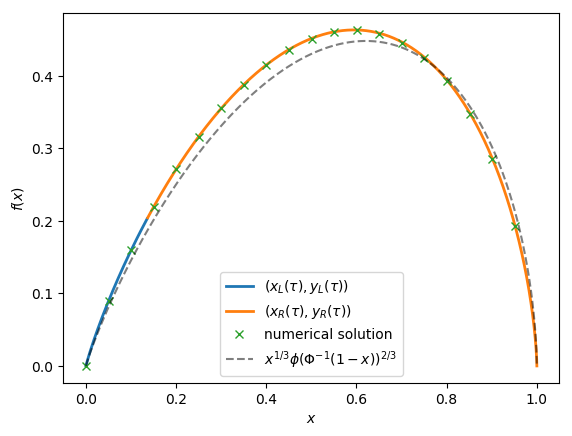I'd like to solve a differential equation $$ f^2(x) f''(x)=-x $$ where $f(x)$ is defined on $[0,1]$ and has a boundary condition $f(0)=f(1)=0$.
I somehow found out that the solution is fairly close to $f(x) = x^{1/3} \phi^{2/3}(\Phi^{-1}(1-x))$ where $\phi$ and $\Phi$ are pdf and cdf of a standard normal distribution, but it fails to solve the differential equation exactly.
Thank for all comments!
Based on the solution structure of Emden–Fowler Equation, I was able to identify the values of constants that satisfy the boundary conditions. The followings are the details:
Define \begin{equation} Z_R(\tau) \triangleq \sqrt{3} J_{1/3}(\tau) - Y_{1/3}(\tau) , \quad Z_L(\tau) \triangleq - \frac{2}{\pi} K_{1/3}(\tau) \end{equation} where $J, Y, K$ are Bessel functions. Further define \begin{equation} \bar{\tau} \triangleq \inf\{ \tau > 0; Z_R(\tau) = 0 \} \approx 2.3834 , \quad a \triangleq \frac{1}{ \bar{\tau}^{4/3} Z_R'(\bar{\tau})^2 } \approx 0.2910 , \quad b \triangleq a \left( \frac{9}{2} \right)^{1/3} \approx 0.1763. \end{equation} Then, the solution curve $\{ (x, f(x)) \}_{x \in [0,1]}$ is characterized by \begin{equation} \left\{ \left( x_R(\tau), y_R(\tau) \right) \right\}_{\tau \in [0, \bar{\tau}]} \bigcup \left\{ \left( x_L(\tau), y_L(\tau) \right) \right\}_{\tau \in [0, \infty]} \end{equation} where \begin{equation} x_R(\tau) \triangleq a \tau^{-2/3}\left[ \left( \tau Z_R'(\tau) + \frac{1}{3} Z_R(\tau) \right)^2 + \tau^2 Z_R(\tau)^2 \right] , \quad y_R(\tau) \triangleq b \tau^{2/3} Z_R(\tau)^2. \end{equation}
\begin{equation} x_L(\tau) \triangleq a \tau^{-2/3}\left[ \left( \tau Z_L'(\tau) + \frac{1}{3} Z_L(\tau) \right)^2 - \tau^2 Z_L(\tau)^2 \right] , \quad y_L(\tau) \triangleq b \tau^{2/3} Z_L(\tau)^2. \end{equation}
In addition to this analytic solution, I also obtained a numerical solution by repeatedly computing $$ f_{k+1}(x) \gets \left[ \left( f_k(x-2h) + f_k(x+2h) \right) + 4 \left(f_k(x-h)+f_k(x+h)\right) + \frac{8 x h^2}{f_k^2(x)} \right] \big/ 10 $$ on the grid $x \in \{2h,3h,\ldots,1-3h,1-2h\}$ for small $h$ with an initialization $f_0(x) \triangleq 0.5(1-(1-2x)^2)$.
The following figure shows these solutions:



